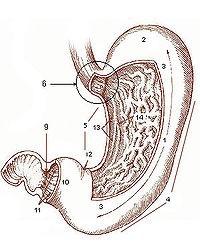The stomach (stomach science, ancient Greek gastir) is an enlargement of the digestive tract of humans and animals. Digestion is the main institution and one of the institutions that make up the gastrointestinal system.
In humans, the stomach has a capacity of 2000 cc and at the top of the abdominal cavity. Communicating with the esophagus with a mouth, called cardiac orifice. Travels down the small intestine, the mouth ulcers. The top of the stomach called the canopy and usually contains gases.The area below the dome, said the body of the stomach, while the region located to the pylorus pyloric called Andro. The wall of the stomach consists of 4 tunics, which is from outside to inside: the orogonos, muscle (well developed and consists of smooth muscle), the ypovlennogonos and pituitary, which are the gastric glands secrete gastric liquid (hydrochloric acid).
In ruminant animals the stomach is divided into 4 sections (rumen, kekryfalos, echinus and inystro) and offered for rumination. In birds the stomach in addition to the muscular stomach, adenodes stomach and crop. Most of the other animals, have one or more digestive sacs.The diseases affecting the stomach and many are due either to abnormality in the secretion of gastric fluid (yperchlorydria - ypochlorydria) or a condition of the institution itself (gastritis, ulcer or cancer). In examining the use of radiography abdomen, barium meal, computed tomography and endoscopic methods.
Διάγραμμα στομάχου
1.Soma stomach
2. Dome
3. Anterior wall
4. Major arc
5. Minor arc
6. Kardia
9. Pyloric sphincter
10. Pylori Andro
11. Mouth ulcers
12. Corner inlay
13. Gastric Street
14. Gstrikes aspects
